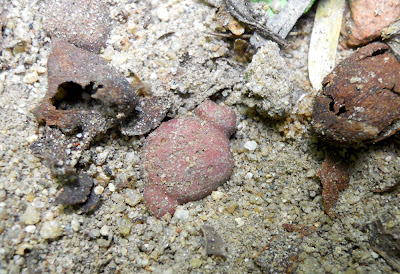This time we chose to visit the ancient Indo-Roman site of Arikamedu. This site has always been of great interest to archaeologists. The earliest documented excavation was by Mortimer Wheeler in the 1940's. He was a well respected and heavily published archaeologist. He conducted an extensive excavation at Arikamedu. This excavation threw up so many artifacts that it brought to light a very important period of India's past; the Indo-Roman trade. However, at that time there was a lot of debate as to the origin of these artifacts. It was concluded at that time that most artifacts found there were of Roman origin and that a lot of pottery techniques found in India originated from Roman techniques. Of the objects found, the most numerous were glass beads and stone beads. This was followed by Roman pottery shards, Red & Black ware, Polished ware and some coarse indigenous terracotta.
 ABOVE: Image 2: Brick walls exposed along the river bank. Wheeler.
ABOVE: Image 2: Brick walls exposed along the river bank. Wheeler.BELOW: Image 3: View of river bank covered with bushes and litter. August 2010

Over the years there have been many other excavations. In the 1980's, Vimala Begley conducted vast excavations at the site. She helped to establish a longer continuity of the region. Her findings allowed us to understand that Arikamedu existed before the arrival of the Romans. There is extensive evidence of Red Ware, Red & Black Ware and Black Ware that are found in habitation mounds all over the area. As recent as January 2010, a sarcophagus and pottery were found a couple of kilometers away from the Arikamedu site. [Link to Article]
Peter Francis Jr. has also greatly contributed the the better understanding of this site. More of his fascinating work can be seen here: Google Books
Today, there is a much larger understanding of Arikamedu, its strategic location, its people and its association with the Indo-Roman trade. Over the years, layer upon layer has been added to the story of Arikamedu by its various researchers. To get a better understanding, one has to see the larger picture.
Arikamedu Timeline:
Arikamedu has been occupied of rover 2700 years. There is evidence that Pandukal people (commonly known as the "megalithic" people) settled in this area in the late Iron age around 500 BCE. There is extensive evidence of large stone circles and dolmens all over the area. There is evidence that this population traded Iron and beads with other regions in India as far away as Gujarat.
The Romans arrived in India through the sea route somewhere around 50BCE in the West coast of India during the rule of Agustus. After initial survey and trade inquiry, it is possible that they figured out a trade route through the Gulf of Mannar, made contact with Ceylone and up the East coast of India and finally reaching China.
There is some evidence that the Bead Trade in Arikamedu flurished till about 300 AD and later moved to an entirely new location at Papanaidupet.
Beads of Arikamedu:
Irrespective of the many types of artifacts found at Arikamedu, beads stand out the most. They are tiny however, found in the millions. This is not an arbitrary figure. Beads were the single larges quantity of products exported from India at that time. Even today, after numerous excavations, one can find thousands of beads scattered on the ground all over the site.
 Discarded end of glass tube. At the bottom of the above image, a 2mm diameter Black Glass Bead can be seen
Discarded end of glass tube. At the bottom of the above image, a 2mm diameter Black Glass Bead can be seen

















